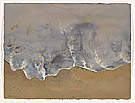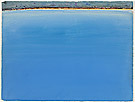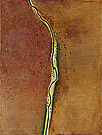Late Works
In 1977 Fred Williams was the first Australian artist to have a solo exhibition at the Museum of Modern Art in New York, the home of works by significant modernist artists he had long admired. A couple of years later, his major multi-panelled Waterfall polyptych 1979 revealed his ongoing interest in Paul Cézanne’s approach of painting multiple viewpoints of a particular location.
Soon after his return to Australia, Williams travelled to the Cape York Peninsula in Far North Queensland resulting in some of his most innovative gouaches. These works were seen by Sir Roderick Carnegie, then Chairman of the mining company CRA (now Rio Tinto), who believed that the artist would benefit greatly from seeing the Pilbara region of Western Australia. Williams made a couple of visits in 1979. He did not agree to a commission but preferred to make works available for consideration later on. His great exhilaration and profound engagement with the region are revealed in oil paintings and especially in a range of brilliant gouaches, some of which are shown in this retrospective for the first time.
The Pilbara paintings were among Williams’s last sustained body of works. Following his untimely death in 1982 they helped to confirm his reputation as one of the most significant landscape artists of the twentieth century.















